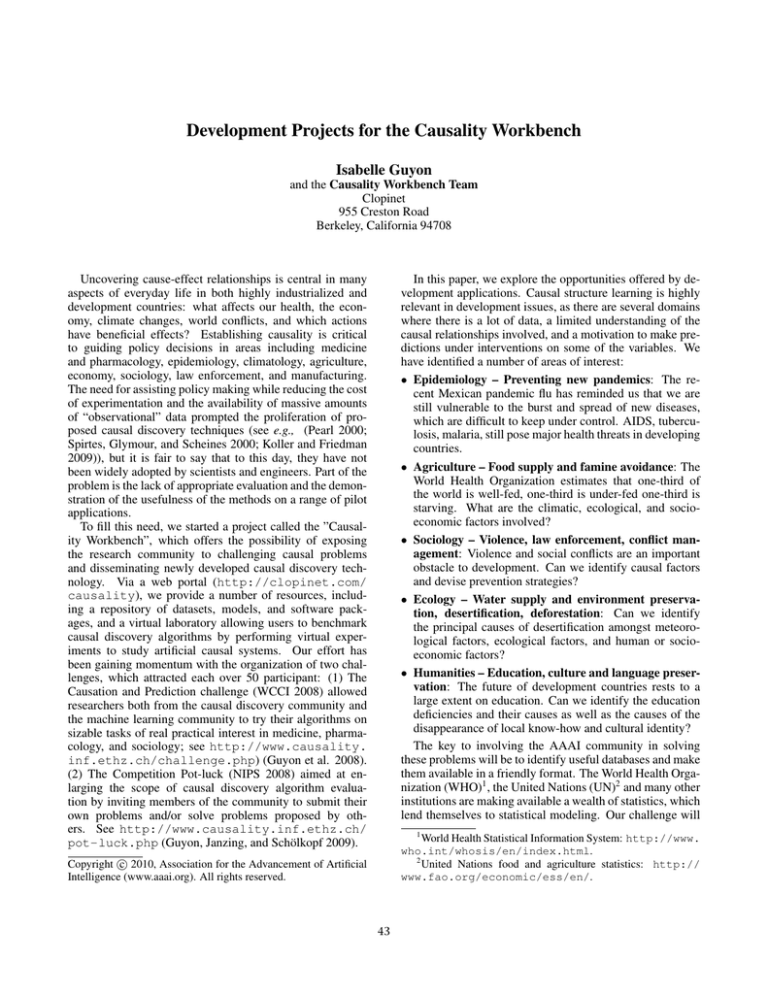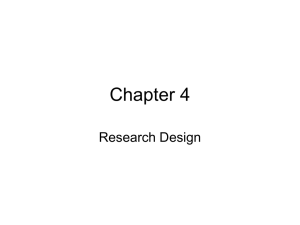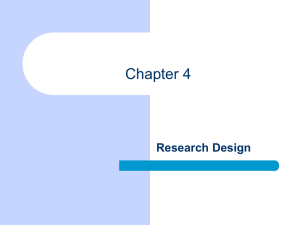
Development Projects for the Causality Workbench
Isabelle Guyon
and the Causality Workbench Team
Clopinet
955 Creston Road
Berkeley, California 94708
Uncovering cause-effect relationships is central in many
aspects of everyday life in both highly industrialized and
development countries: what affects our health, the economy, climate changes, world conflicts, and which actions
have beneficial effects? Establishing causality is critical
to guiding policy decisions in areas including medicine
and pharmacology, epidemiology, climatology, agriculture,
economy, sociology, law enforcement, and manufacturing.
The need for assisting policy making while reducing the cost
of experimentation and the availability of massive amounts
of “observational” data prompted the proliferation of proposed causal discovery techniques (see e.g., (Pearl 2000;
Spirtes, Glymour, and Scheines 2000; Koller and Friedman
2009)), but it is fair to say that to this day, they have not
been widely adopted by scientists and engineers. Part of the
problem is the lack of appropriate evaluation and the demonstration of the usefulness of the methods on a range of pilot
applications.
To fill this need, we started a project called the ”Causality Workbench”, which offers the possibility of exposing
the research community to challenging causal problems
and disseminating newly developed causal discovery technology. Via a web portal (http://clopinet.com/
causality), we provide a number of resources, including a repository of datasets, models, and software packages, and a virtual laboratory allowing users to benchmark
causal discovery algorithms by performing virtual experiments to study artificial causal systems. Our effort has
been gaining momentum with the organization of two challenges, which attracted each over 50 participant: (1) The
Causation and Prediction challenge (WCCI 2008) allowed
researchers both from the causal discovery community and
the machine learning community to try their algorithms on
sizable tasks of real practical interest in medicine, pharmacology, and sociology; see http://www.causality.
inf.ethz.ch/challenge.php) (Guyon et al. 2008).
(2) The Competition Pot-luck (NIPS 2008) aimed at enlarging the scope of causal discovery algorithm evaluation by inviting members of the community to submit their
own problems and/or solve problems proposed by others. See http://www.causality.inf.ethz.ch/
pot-luck.php (Guyon, Janzing, and Schölkopf 2009).
In this paper, we explore the opportunities offered by development applications. Causal structure learning is highly
relevant in development issues, as there are several domains
where there is a lot of data, a limited understanding of the
causal relationships involved, and a motivation to make predictions under interventions on some of the variables. We
have identified a number of areas of interest:
• Epidemiology – Preventing new pandemics: The recent Mexican pandemic flu has reminded us that we are
still vulnerable to the burst and spread of new diseases,
which are difficult to keep under control. AIDS, tuberculosis, malaria, still pose major health threats in developing
countries.
• Agriculture – Food supply and famine avoidance: The
World Health Organization estimates that one-third of
the world is well-fed, one-third is under-fed one-third is
starving. What are the climatic, ecological, and socioeconomic factors involved?
• Sociology – Violence, law enforcement, conflict management: Violence and social conflicts are an important
obstacle to development. Can we identify causal factors
and devise prevention strategies?
• Ecology – Water supply and environment preservation, desertification, deforestation: Can we identify
the principal causes of desertification amongst meteorological factors, ecological factors, and human or socioeconomic factors?
• Humanities – Education, culture and language preservation: The future of development countries rests to a
large extent on education. Can we identify the education
deficiencies and their causes as well as the causes of the
disappearance of local know-how and cultural identity?
The key to involving the AAAI community in solving
these problems will be to identify useful databases and make
them available in a friendly format. The World Health Organization (WHO)1 , the United Nations (UN)2 and many other
institutions are making available a wealth of statistics, which
lend themselves to statistical modeling. Our challenge will
1
World Health Statistical Information System: http://www.
who.int/whosis/en/index.html.
2
United Nations food and agriculture statistics: http://
www.fao.org/economic/ess/en/.
c 2010, Association for the Advancement of Artificial
Copyright Intelligence (www.aaai.org). All rights reserved.
43
include integrating data from various sources. For example,
for the famine problem, one may need to rely upon satellite data,3 , geographical conflict information,4 , and general
statistics from WHO, UN, etc. Validating methodologies
and findings is challenging, but can be done both by studying retrospective data and comparing predictions against the
results of simulations. Realistic simulators, such as the epidemiology simulator STEM5 are valuable resources. Finally, we also have information available, which can be used
to identify the most effective actions6 . These data can be
used for learning from experimental data.
Our next challenge on “Active Learning” (in preparation, see http://www.causality.inf.ethz.ch/
activelearning.php, login: causality, password:
vlab09), will incorporate datasets on applications of interest to the development community, including:
We plan to attach to the virtual lab sizeable realistic simulators such as the Spatiotemporal Epidemiological Modeler (STEM), an epidemiology simulator developed at IBM, now publicly available:
http://www.eclipse.org/stem/.
We have
two planned challenges using the Virtual Lab: ExpDeCo
(Experimental Design in Causal Discovery) will benchmark
methods of experimental design in application to causal
modeling. CoMSICo (Causal Models for System Identification and Control) will perform a continuous evaluation
of causal models rather than separating training and test
phase. The participants will be in charge of making their
own plan of action (policy) to optimize an overall objective
(e.g., improve the life expectancy of a population, improve
the GNP, etc.) and they will be judged directly with this
objective.
While some of our core activities focus on benchmarking
algorithms, we realize that discovery and problem-solving
are critical aspects, which cannot always be quantitatively
evaluated on the short run, yet need immediate attention
from the research community. With the collaboration of
other researchers we will enroll at the AAAI Spring Symposium on Artificial Intelligence for Development, we intend
to populate our repository with development-related problems. We intend to involve interested participants in the organization of a new “pot-luck challenges”, specifically on
development problems.
• Pharmacology: Discovery of molecules and mechanisms
of action against the HIV virus and tuberculosis.
• Ecology: Identification of vegetation cover from remote
sensing.
• Culture preservation: Electronic annotation of ancien
arabic manuscripts.
It will take place before the AAAI Spring Symposium on Artificial Intelligence for Development and we will encourage
researchers from that community to enter it to gain familiarity with causal tasks.
Methods for learning cause-effect relationships without
experimentation (learning from observational data) are attractive because observational data is often available in
abundance and experimentation may be costly, unethical,
impractical, or even plain impossible. Still, many causal
relationships cannot be ascertained without the recourse to
experimentation and the use of a mix of observational and
experimental data might be more cost effective. We implemented a Virtual Lab allowing researchers to perform experiments on artificial systems to infer their causal structure.
The design of the platform is such that:
Acknowledgments
This project is an activity of the Causality Workbench supported by the Pascal network of excellence funded by the
European Commission and by the U.S. National Science
Foundation under Grant N0. ECCS-0725746. Any opinions,
findings, and conclusions or recommendations expressed in
this material are those of the authors and do not necessarily
reflect the views of the National Science Foundation. We
are very grateful to all the members of the causality workbench team for their contribution to organizing past challenge: Constantin Aliferis, Greg Cooper, André Elisseeff,
Jean-Philippe Pellet, Peter Spirtes, and Alexander Statnikov.
• Researchers can submit new artificial systems for others
to experiment.
References
• Experimenters can place queries and get answers.
Guyon, I.; Aliferis, C.; Cooper, G.; Elisseeff, A.; Pellet, J.P.; Spirtes, P.; and Statnikov, A. 2008. Design and analysis
of the causation and prediction challenge. In JMLR W&CP,
volume 3, 1–33.
Guyon, I.; Janzing, D.; and Schölkopf, B. 2009. Causality:
Objectives and assessment. In JMLR W&CP, volume 6,
1–42.
Koller, D., and Friedman, N. 2009. Probabilistic Graphical
Models: Principles and Techniques. MIT Press.
Pearl, J. 2000. Causality: Models, Reasoning, and Inference. Cambridge University Press.
Spirtes, P.; Glymour, C.; and Scheines, R. 2000. Causation, Prediction, and Search. Cambridge, Massachusetts,
London, England: The MIT Press.
• The activity is logged.
• Registered users have their own virtual lab space.
We have released a first version http://www.
causality.inf.ethz.ch/workbench.php.
3
NASA satellite data to predict famine:
http:
//www.scientificblogging.com/news/using_
nasa_satellites_to_predict_famine.
4
Nobel prize foundation conflict maps:
http:
//nobelprize.org/educational_games/peace/
conflictmap/.
5
Model of the Mexican Pandemic publicly available for
the STEM simulator: http://www.eclipse.org/stem/
download_sample.php?file=UsaMexicoDemo.zip.
6
For instance the web sites rating charities like http://www.
charitynavigator.org/.
44









